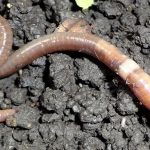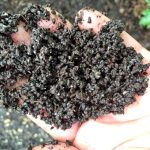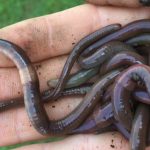Asian Jumping Worm
Identification:
Asian jumping worms are smooth, glossy gray or brown and 1.5 to 8 inches long. Jumping worms are similar in appearance to earthworms (also known as nightcrawlers) but can be distinguished by the jumping worm’s thrashing movements. Earthworms have a raised clitellum (a light-colored band wrapping the worm’s body) that does not fully encircle the body, whereas jumping worms have a flat clitellum, often gray or milky white in color, with no gap. They can often be found on the surface of trails and if disturbed will thrash and slither similar to a snake.
It is also possible to identify an area as having a jumping worm problem through their castings. In an area with a large population, the top layer of dirt will be void of organic material. The castings the worms leave behind give the soil the appearance of coffee grounds, and are generally very loose.
Control:
To prevent the spread of Asian jumping worms, it is important to know the sources of any compost, soil, mulch, or fill coming onto your property. Much of the spread of this pest can be attributed to these sources. The egg cocoons can survive in the compost for a significant amount of time. Compost can be certified to be jumping worm free, but the safest way to get these products is to allow them to bake in a hot sunny spot, on top of concrete before applying the mulch or compost to the soil. The heat can kill off any worms that may have made it into the fill.
Additionally, when visiting areas that are infected with jumping worms, it is very important to clean any dirt of off boots, tires, etc., before leaving the area. Keep an eye out for signs warning of jumping worm infestations of kiosks at conservation trailheads, as they have already been identified at Davis Farm, Piper Farm, King Phillips Woods, and other conservation parcels.
Once jumping worms are established somewhere it is nearly impossible to remove them, however it is possible to limit their numbers and slow their spread. If you see any adult jumping worms, they can be picked up and placed inside a plastic container where they will dry out and die.



